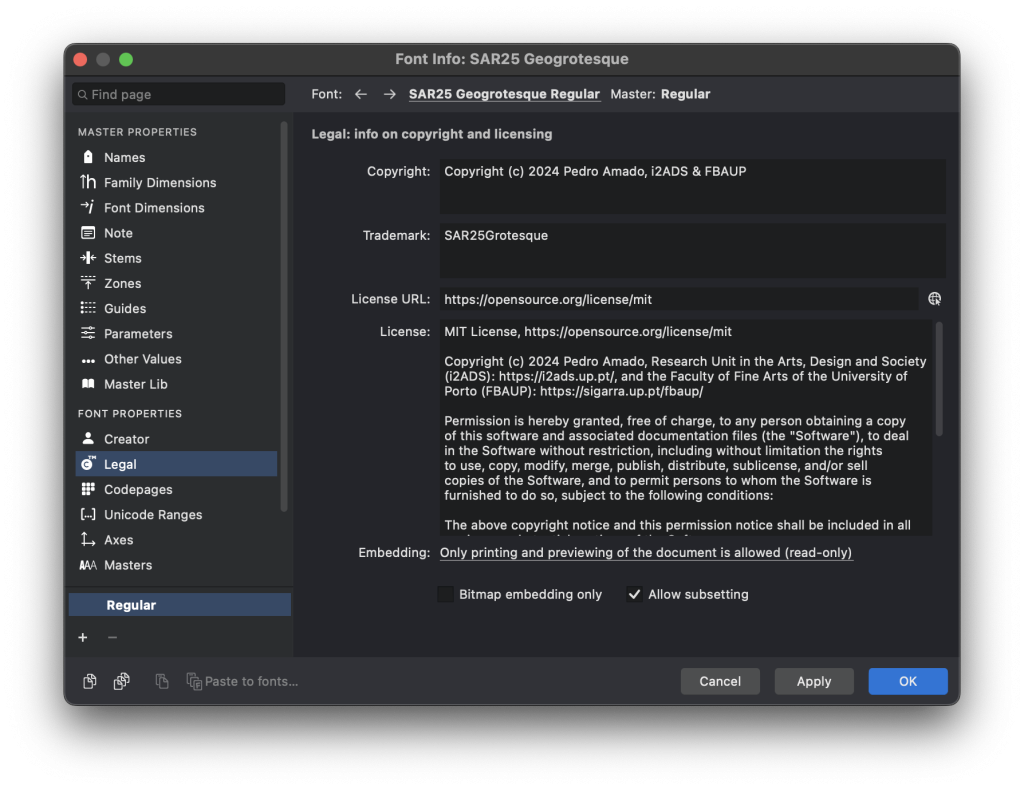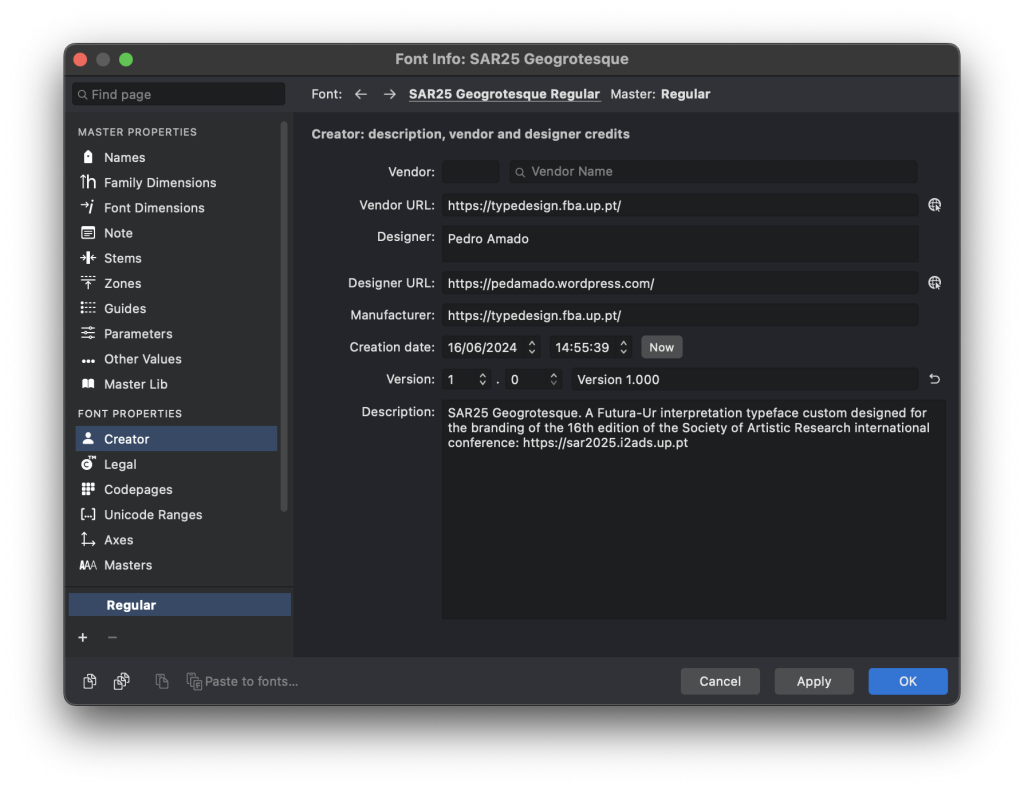When a digital type design project is ready for publishing and distribution, it is important to check your legal information before exporting the final WOFF, OpenType and Variable Font files.
This year, students have been asking how to do this. The final copyrights notice and legal (EULA) license information is the target of much discussion in the industry.

Personally, I would recommend every student to publish their fonts with an Open Source License. Being it a SIL Open Font License, MIT, or Creative Commons Attribution Non-Commercial Share Alike licenses.
This will avoid the murky waters of the shared ownership of the student and the university as stated in the article 3 of the intellectual property regulation of the University of Porto. This is a common legal document and may be similar in other institutions. Having it published, with proper credits, and with an Open Source license, doesn’t clear all the issues but will avoid the complicated financial issues…
In any case, as one can read in the SIL website, it is always important to fill both the Creator and Legal Font Information panels, with as much information possible to avoid legal a “limbo”.
The basic copyright statement takes the form:
Font Development Best Practices, 2024: https://silnrsi.github.io/FDBP/en-US/Copyright_and_Licensing.html
Copyright (c) 2016 Sarah Singh
This is the basic information. But as you can read in SIL’s website, you may specify multiple authors, and you should discriminate institutions also. Additional information about specific portions of the copyrights may also be discriminated:
The statement may span multiple years, with optional comma, and even include multiple joint copyright holders (…) If different portions of the software have different copyright holders, two copyright statements would be used, each indicating the part of the software that it applies to…
SIL also recommends adding a URL. This may be more volatile, but nevertheless, it may help to identify and provide proper attribution.
Which means that in the case of an academic project, it may be even more difficult to specify. The simplest form would be: Copyright (c) 2023–2024 <First Student Name> and <Additional Students Names>. Project briefing and Design Supervision copyright (c) 2023 <Professor(s) Name(s)>. <Course Name>, <Research Unit>, and <Department, Faculty or University main Institution or Legal Entity>, <URLs>
In this specific course, I would recommend using the following:
Copyright (c) 2023–2024 Ana Silva, Maria Silva and Manuel Silva. Project briefing and Design Supervision copyright (c) 2023 Pedro Amado and the Typeface Design Course from the Master in Graphic Design and Editorial Projects (MDGPE) of the Design Department of the Faculty of Fine Arts of the University of Porto (FBAUP): https://typedesign.fba.up.pt/
SIL also recommends “The same copyright statement(s) should also be in the font package documentation, typically in a LICENSE or ReadMe [text] file”
Therefor, as an example I would recommend using the CC-BY-NC-SA License, with a final disclaimer from the MIT:
Creative Commons Attribution-NonCommercial-ShareAlike 4.0 International License: https://creativecommons.org/licenses/by-nc-sa/4.0/
Copyright (c) 2023–2024 <Designers Names> and / or <legal Entities>.
You are free to: Share — copy and redistribute the material in any medium or format; Adapt — remix, transform, and build upon the material. The licensor cannot revoke these freedoms as long as you follow the license terms.
Under the following terms: Attribution — You must give appropriate credit , provide a link to the license, and indicate if changes were made . You may do so in any reasonable manner, but not in any way that suggests the licensor endorses you or your use; Non-Commercial — You may not use the material for commercial purposes; Share Alike — If you remix, transform, or build upon the material, you must distribute your contributions under the same license as the original.
No additional restrictions: You may not apply legal terms or technological measures that legally restrict others from doing anything the license permits.
Notices: You do not have to comply with the license for elements of the material in the public domain or where your use is permitted by an applicable exception or limitation; The license may not give you all the permissions necessary for your intended use. For example, other rights such as publicity, privacy, or moral rights may limit how you use the material.
The software is provided “as is”, without warranty of any kind, express or implied, including but not limited to the warranties of merchantability, fitness for a particular purpose and noninfringement. In no event shall the authors or copyright holders be liable for any claim, damages or other liability, whether in an action of contract, tort or otherwise, arising from, out of or in connection with the software or the use or other dealings in the software.
Additionally, don’t forget to add your personal details in the Creator panel. And, of course, to include the creative/original brief of the typeface design in the Description field.
